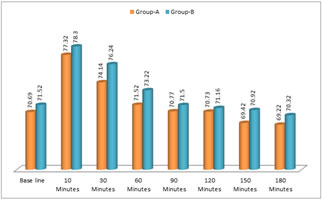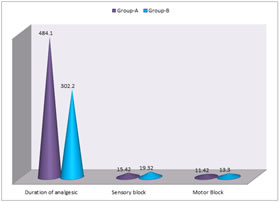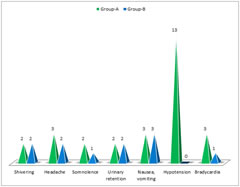|
Table of Content - Volume 21 Issue 1 - January 2022
Comparison of efficacy of analgesic like nalbupine with hyperbaric bupivacaine and pentazocine with hyperbaric bupivacaine - A retrospective study
M Linga Murthy
Assistant Professor, Department of Anaesthesia, SVS Medical College Mahaboob Nagar, Telangana, INDIA. Email: mlmurthy38@gmail.com
Abstract Background: Severe or un-controlled pain may cause myocardial infarction or ischemia. Hence every anaesthesiologist prefers long acting pain relief analogist drugs. Hence efficacies of different drugs were compared with their duration of sensory and motor blockage with least side effects and cost-effective. Method: Out of 80 patients, 40 patients (group-A) anaesthetized with Hyperbaric bupivacaine and Nalbuphine and 40 patients (group-B) with Hyperbaric bupivacine and pentazocaine undergoing major abdominal and pelvic surgery. Their heart rate, nerve blockage was studied and compared. Results: VAS analogue were higher in group-A. Heart rates in different time intervals nerve blockage in both groups had significant (p<0.00) p value and least side effects were observed in group-B patients. Conclusion: Group-B analgesic pentazocaine with hyperbaric Bupivacaine was more efficient better relief for post surgical pain with least side effects as compared to group-A analgesics Keywords: HR=Heart rate, Sensory lock, Motor block, Analgesic, Telangana
INTRODUCTION Bupivacaine acts mainly blockade of voltage gated Na+ Channels in the axonal membrane and possibly has a further effect on pre-synaptic inhibition of calcium channels.1 The use of adjuvant such as nalbuphine with bupivacaine has shown to reduce its dose requirements in spinal anaesthesia with reduced incidence of side effects and reduced dosage of analgesia.2 Intrathecal anaesthesia is to block the nerve endings of both motor and sensory but the analgesia drugs which causes anaesthesia for longer duration is preferred, by keeping in view of their side effects Hyperbaric bipuvacaine as a spinal anaesthesia but to increase the duration of sensory blockade to prolong post-operative analgesia hyper bupivacaine is added to Nalbuphine but in some patients could not had satisfactory post-operative analgesic hence hyper baric Bupivacaine is added with pentazocine.3,4 Hence attempt was to compare duration of sensory and motor block and rate of side effects so that both group patients of both sexes get relief post surgically for longer duration.
MATERIAL AND METHOD Total 80 patients (40 male and 40 female) aged between 20 to 60 years admitted in surgical ward of SVS Medical College hospital Mahabub Nagar – 509001 Telanagana. Inclusive Criteria: Patients undergoing major abdominal and pelvic surgery certified fitness by physician for surgery were selected for study. Exclusion Criteria: Patients suffering from cardiac arrhythmias, heart block, and Bradycardia patients with known allergy for study drugs to test dosage, patients with gross spinal abnormality, localised skin sepsis haemorrhagic diathesis, patients on anti-depressant drugs were excluded from study.
METHOD The present study was hospital based prospective comparative study conducted in department of Anaesthesiolology S V S medical college hospital mahbub Nagar -509001 Telangana 80 patients 20 males and 20 females were selected for each group (group-A and B)
Every patients undergoing major surgery of abdomen and pelvic organs were explained the procedure of spinal anaesthesia and got written consent from patients. The fitness of the every patient was confirmed by physician (pathological report and radiologist) spinal anaesthesia was performed at the level of L3-L4 with 25 Quickie needle. Heart rate, RR rate duration of analgesic sensory block, motor block values were noted and compared from both groups. The duration of study was Four months December-2019 to June-2019 Statistical analysis: The obtained values from both groups were compared with z test. The statistical analysis was performed in SPSS software.
OBSERVATION AND RESULTS Table-1 (A): 40 patient’s visual analogue scale in group-A patients Grade-I: MV – 3 (7.5%), grade-II 7 (17.5%), grade-III MV-9 (22.5%), grade-IV 21 (52.5%) In group-B: Patients (40 patients) grade-I 2 (5%), grade-II 8 (20%), grade-III 19 (47.5%), grade-IV 11 (27.5%) Table-2: Comparison of heart rate values in both group-A and B groups at different intervals. Baseline – Mean value 70.6 (±0.245) in group-A, 71.5 (±0.295) in group-B, t test 13.9 and p<20.00 10 Minutes: Mean value 77.3 (± 0.121) in group-A, 78.3 (± 0.120) in group-B, t test 35.04 and p<0.00 30 Minutes: Mean value 74.15 (± 0.024) in group-A, 76.2 (± 0.115) in group-B, t test 38.6 and p<0.000 60 Minutes: Mean value 71.5 (± 0.183) in group-A, 73.2 (± 0.150) in group-B, t test 45.4 and p<0.00 90 Minutes: Mean value 70.7 (± 0.035) in group-A, 71.5 (±0.073) in group-, t test 33.07 and p<0.00 120 Minutes: Mean value 70.7 (± 0.35) in group-A, 71.1 (± 0.033) in group-B, t test 56.5 and p<0.00 150 Minutes: Mean value 69.4 (± 0.027) in group-A, 70.9 (± 0.025) in group-B, t test 75.7 and p<0.00 180 Minutes: mean value 69.2 (± 0.026) in group-A, 70.3 (±0.018) in group-B, t test value was 55.5 and p<0.00 Table-3: Comparison of duration of analgesic, sensory block, Motor block values in both A and B group Duration of analysis – Mean value 484.1 (±24.2) in group-A, 302.2 (± 4.89) in group-B and t test was 38.6 and p<0.00 Sensory Block (Minutes) – Mean value 153.42 (± 0.352) in group-A, 19.32 (± 0.358) in group-B and t test was -49.1, p<0.00 Motor Block (Minutes) – Mean value 11.42 (± 0.17) in group-A, 13.30 (± 0.30) and t test was -34.9 and p<0.000 Table-4: Study of side effects in both A and B groups Shivering – 2 (5%) in group-A and group-B Headache – 3 (7.5%) in group-A, 2 (5%) in group-B Somnolence – 2 (5%) in group-A, 1 (2.5%) in group-B Urinary retention – 2 (5%) in group-A and group-B Nausea and vomiting – 3 (7.5%) in group-A and B Hypotension – 11 (27.5%) in group-A, 13 (32.5%) in group-B Bradycardia – 3 (7.5%) in group-A and 1 (2.5%) in group-B Table 1 (A): Visual Analogue scale in group-A patients (No of 40 patients)
Table 1 (B): Visual analogue scale in group- patients(No of 40 patients)
MV = Mask Ventilation
Table 2: Comparison of heart rate values in both groups (A and B) at different time intervals (No. of patients 40 + 40 = 80)
Table 2: Comparison of heart rate values in both groups (A and B) at different time intervals
Table 3: Comparison of duration of analgesic, sensory block and motor block values in both group (A and B)
Table 3: Comparison of duration of analgesic, sensory block and motor block values in both group (A and B)
Table 4: Study of side effects in both groups (A and B)
Table 4: Study of side effects in both groups (A and B)
DISCUSSION Present comparative study of efficacy of analgesic like Nulbupine with Hyperbaric and pantazocaine with Hyperboric bupivacaine. In visual analogue scale in group-A patients Grade-I had MV 3 (7.5%), grade-II had MV 7 (17.5%), grade-III had MV 9 (22.5%) and grade-IV had 21 (52.5%). In group-B patients visual analogue scale was – grade-I MV 2 (5%), grade-II MV 8 (20%), grade-III MC 19 (47.5%), grade-IV MV 11 (29.5%) (Table-1) In comparison of heart rate values at different time interval of 10 minutes, 30 minutes, 60 minutes, 90 minutes, 120 minutes, 150 minutes and 180 minutes the p value was highly significant in every interval of time (p<0.001) Table-2. In comparison of duration of analgesic, neural block values of both A and B groups. In duration of analgesic mean value 484.1 (± 0.352) in group-A, 302.2 (± 4.82) in group-B, t test 38.6 and p value was highly significant (p<0.00). In sensory block mean value 15.42 (± 0.352) in group-A, 19.32 (± 0.358) in group-B, t test -49.1 and p value was highly significant (p<0.00). In motor block mean value 11.42 (± 0.170 in group-A, 13.30 (± 0.30) in group-B, patient t test -34.4 and p value was highly significant (p<0.00). These findings are more or less in agreement with previous studies.5,6,7 Visual analogue scale (VAS) is to assess the post-operative pain, Nausea pruritis and somnolence. It was observed that high rates in group-A patients as compared to group- patients.8 In group-B heart rate values were more than group-B. It certainly indicates that, the analgesic group- (Hyperbaric Bipuvacaine + pantazocine) was quite effective than group-A (Hyperbaric Bipuvacaine Nalbupine 1 mg). Bipuvacaine is an amido – amine anaesthetic of high potency and long duration due to its high liposolubality property they develop enough interstitial pressure to cause diffusion of injected material in the dependent region out causes respiratory depression, nausea, vomiting and psycho mimic reaction were also observed.9 Pantazocine is the N-ally derivative of narcotic analgesic phenazocaine it is the strong analgesic with weak narcotic antagonist activity. It is advocated for moderate to severe pain. Pentozocaine has low abuse potential and is not controlled by narcotic regulation.10 Hence it is safer than Nalbuphine. Nalbuphine may provide better pain relief than pentazocaine but it has high rate of side effects as compared to pentazocaine.
SUMMARY AND CONCLUSION The comparative study between group-A and group-B though both groups have beneficiary. The group-B analgesics Hyperbaric Bupivacaine and pentazocaine proved better than group-A administrated intrathecally (spinal) anaesthesia because of prolonged analgesic effect with minimal side effects post-surgically. But this study demands further pharmacological, patho-physiological, cardio-vascular, nutritional, genetic studies because exact factors and mechanism of analgesic is still unclear.
REFERENCES
Policy for Articles with Open Access
|
|
||||||||||||||||||||||||||||||||||||||||||||||||||||||||||||||||||||||||||||||||||||||||||||||||||||||||||||||||||||||||||||||||||||||||||||||||||||||||||||||||||||||||||||||||||||||||||||||||
 Home
Home



